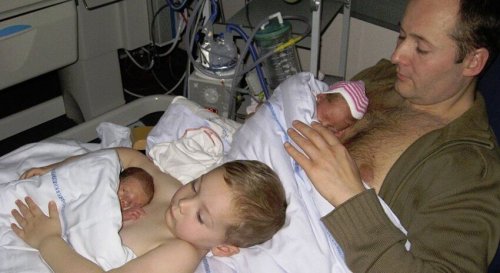Skin-to-Skin Contact During the First Months of Life


Written and verified by the psychologist Valeria Sabater
The kangaroo method or skin-to-skin contact is a technique commonly practiced with newborns so that this first physical imprint that’s so full of warmth favors the beginning of breastfeeding and the bond between mother and child. However, numerous studies recommend that we continue practicing this method continuously during the first months of life
Neonatology experts call it kangaroo care. It was in the early 1970s when in Bogotá, the capital of Columbia–a country with an incredibly high mortality rate at this time–it was discovered that something as simple as placing a newborn on its mother’s chest significantly increased the survival of infants. Especially premature babies.
The kangaroo method improved heart rate, breathing pattern, and oxygen saturation. The kangaroo method (named for how marsupials carry their young in their pouches) worked, so it didn’t take long for this practice to spread to several hospitals in the United States, and then to the rest of the world.
Now, there’s one thing to keep in mind. People always talk about the benefits of skin-t0-skin contact during the first hours of life, and that it’s an incredibly suitable technique for premature babies. However, we mustn’t forget an interesting aspect: If we extend the “kangaroo care” during the first months of life, we further favor the bond with our child and their proper maturation
Below, we’ll offer you all the information you need regarding skin-to-skin contact during the first months of life.
Skin-to-skin to welcome your newborn
They say there’s nothing as mysterious as being born. If we stop for a moment to look back and try to remember our own birth, we realize that all of those memories have long since been erased. We don’t remember it at all.
However, there are many neurologists and neonatologists who tell us that being born can be something very that’s traumatic and that it can leave a mark on us.

Just mentioning some of the experiences to which we’re exposed at birth makes us understand why some experts assert the severity of such an event.
We leave a calm and safe environment to be uprooted, sometimes abruptly. Next, several hands begin to manipulate us, cut our umbilical cord, and wash us, while we wonder where we are. And where’s that mother that, up until a few minutes ago, we were part of?
The first hour after birth is sacred and belongs to the mother and child. Therefore, the kangaroo method is an essential protocol that all hospitals must implement:
Benefits of the “kangaroo method” after childbirth
- The transition from fetal life to the outside world is fostered with more harmony and less stress. It’s a warmer and more loving welcome.
- One of the greatest benefits of skin-to-skin contact has been found to be better oxygen saturation rate and regulation of the baby’s body temperature.
- Nor can we forget that the negative effects of the separation between mother and child are reduced. This very common event produces a high level of stress in a child’s brain, something that we can avoid with such a simple, wonderful, and accommodating technique such as placing mother and baby skin to skin.
- Babies are also born with the instinctive ability to find the breast and thus start breastfeeding. Skin-to-skin contact promotes this very natural behavior, something that must be started as soon as the baby is born.
- Even if the delivery was by cesarean section, it’s still necessary to practice the kangaroo method. Now, we all know that this isn’t always put into practice in hospitals, as after a cesarean section, it’s common for the baby to go to the nursery and the mother to go to rest. This is something that should be improved as long as conditions are favorable.

Skin-to-skin for the first month of life, including with dad
The power of the warmth and the smell of the skin, of that warm closeness where two hearts pump at the same time, has no comparison with anything else. Babies don’t just need breast milk or a bottle to grow up in harmony and happiness. Food isn’t everything.
- In order to mature normally, closeness, caresses, and security are absolutely necessary. An affectionate environment is the most incredible tool to favor the neuronal connection of the brain, which is building its reality based on what it feels, what it perceives, and what the world offers it.
- So why deprive a child of our skin if it’s what helps them most to regulate stress and obtain security? Breastfeeding itself already generates that union and that exceptional bond, but if a family wishes, we can extend that contact for months.

Skin-to-skin contact from either mom or dad is known to improve a child’s cognitive skills and emotional maturity. So, it’s worth promoting it by involving our partners or even older siblings if possible. Why not? To do this, just follow these routines.
How to put the kangaroo method into practice during the first months of life
- Undress your chest, taking off your shirt or bra.
- The baby will wear their diaper and, if you want, a cap.
- Place the child in a vertical position on top of you and then cover them with a blanket.
- Let the baby rest. It’s your time, it’s their time. Enjoy the here now and listen to your breathing.
- 4 to 5 hours per week should be adequate in most cases.
So don’t hesitate to extend the skin-to-skin experience as much as you want and as possible.
The kangaroo method or skin-to-skin contact is a technique commonly practiced with newborns so that this first physical imprint that’s so full of warmth favors the beginning of breastfeeding and the bond between mother and child. However, numerous studies recommend that we continue practicing this method continuously during the first months of life
Neonatology experts call it kangaroo care. It was in the early 1970s when in Bogotá, the capital of Columbia–a country with an incredibly high mortality rate at this time–it was discovered that something as simple as placing a newborn on its mother’s chest significantly increased the survival of infants. Especially premature babies.
The kangaroo method improved heart rate, breathing pattern, and oxygen saturation. The kangaroo method (named for how marsupials carry their young in their pouches) worked, so it didn’t take long for this practice to spread to several hospitals in the United States, and then to the rest of the world.
Now, there’s one thing to keep in mind. People always talk about the benefits of skin-t0-skin contact during the first hours of life, and that it’s an incredibly suitable technique for premature babies. However, we mustn’t forget an interesting aspect: If we extend the “kangaroo care” during the first months of life, we further favor the bond with our child and their proper maturation
Below, we’ll offer you all the information you need regarding skin-to-skin contact during the first months of life.
Skin-to-skin to welcome your newborn
They say there’s nothing as mysterious as being born. If we stop for a moment to look back and try to remember our own birth, we realize that all of those memories have long since been erased. We don’t remember it at all.
However, there are many neurologists and neonatologists who tell us that being born can be something very that’s traumatic and that it can leave a mark on us.

Just mentioning some of the experiences to which we’re exposed at birth makes us understand why some experts assert the severity of such an event.
We leave a calm and safe environment to be uprooted, sometimes abruptly. Next, several hands begin to manipulate us, cut our umbilical cord, and wash us, while we wonder where we are. And where’s that mother that, up until a few minutes ago, we were part of?
The first hour after birth is sacred and belongs to the mother and child. Therefore, the kangaroo method is an essential protocol that all hospitals must implement:
Benefits of the “kangaroo method” after childbirth
- The transition from fetal life to the outside world is fostered with more harmony and less stress. It’s a warmer and more loving welcome.
- One of the greatest benefits of skin-to-skin contact has been found to be better oxygen saturation rate and regulation of the baby’s body temperature.
- Nor can we forget that the negative effects of the separation between mother and child are reduced. This very common event produces a high level of stress in a child’s brain, something that we can avoid with such a simple, wonderful, and accommodating technique such as placing mother and baby skin to skin.
- Babies are also born with the instinctive ability to find the breast and thus start breastfeeding. Skin-to-skin contact promotes this very natural behavior, something that must be started as soon as the baby is born.
- Even if the delivery was by cesarean section, it’s still necessary to practice the kangaroo method. Now, we all know that this isn’t always put into practice in hospitals, as after a cesarean section, it’s common for the baby to go to the nursery and the mother to go to rest. This is something that should be improved as long as conditions are favorable.

Skin-to-skin for the first month of life, including with dad
The power of the warmth and the smell of the skin, of that warm closeness where two hearts pump at the same time, has no comparison with anything else. Babies don’t just need breast milk or a bottle to grow up in harmony and happiness. Food isn’t everything.
- In order to mature normally, closeness, caresses, and security are absolutely necessary. An affectionate environment is the most incredible tool to favor the neuronal connection of the brain, which is building its reality based on what it feels, what it perceives, and what the world offers it.
- So why deprive a child of our skin if it’s what helps them most to regulate stress and obtain security? Breastfeeding itself already generates that union and that exceptional bond, but if a family wishes, we can extend that contact for months.

Skin-to-skin contact from either mom or dad is known to improve a child’s cognitive skills and emotional maturity. So, it’s worth promoting it by involving our partners or even older siblings if possible. Why not? To do this, just follow these routines.
How to put the kangaroo method into practice during the first months of life
- Undress your chest, taking off your shirt or bra.
- The baby will wear their diaper and, if you want, a cap.
- Place the child in a vertical position on top of you and then cover them with a blanket.
- Let the baby rest. It’s your time, it’s their time. Enjoy the here now and listen to your breathing.
- 4 to 5 hours per week should be adequate in most cases.
So don’t hesitate to extend the skin-to-skin experience as much as you want and as possible.
All cited sources were thoroughly reviewed by our team to ensure their quality, reliability, currency, and validity. The bibliography of this article was considered reliable and of academic or scientific accuracy.
- Abdulghani, N., Edvardsson, K., & Amir, L. H. (2018). Worldwide prevalence of mother-infant skin-to-skin contact after vaginal birth: A systematic review. PloS one, 13(10), 1–19. https://pubmed.ncbi.nlm.nih.gov/30379859/
- American Academy of Pediatrics Committee on Fetus and Newborn, American College of Obstetricians and Gynecologists Committee on Obstetric Practice, Watterberg, K. L., Aucott, S., Benitz, W. E., Cummings, J. J., … & Wharton, K. R. (2015). The apgar score. Pediatrics, 136(4), 819–822. https://www.acog.org/clinical/clinical-guidance/committee-opinion/articles/2015/10/the-apgar-score
- Bigelow, A. E., & Power, M. (2020). Mother–infant skin-to-skin contact: short‐and long-term effects for mothers and their children born full-term. Frontiers in Psychology, 11, 1–9. https://www.frontiersin.org/articles/10.3389/fpsyg.2020.01921/full
- Crenshaw, J. T. (2014). Healthy Birth Practice #6: Keep Mother and Baby Together- It’s Best for Mother, Baby, and Breastfeeding. The Journal of Perinatal Education, 23(4), 211–217. https://www.ncbi.nlm.nih.gov/pmc/articles/PMC4235060/
- Herrera, A. (2013). El contacto piel con piel de la madre con el recién nacido durante el parto. Index de Enfermería, 22(1), 79–82. https://scielo.isciii.es/scielo.php?script=sci_arttext&pid=S1132-12962013000100017
- Karimi, F. Z., Miri, H. H., Khadivzadeh, T., & Maleki-Saghooni, N. (2020). The effect of mother-infant skin-to-skin contact immediately after birth on exclusive breastfeeding: a systematic review and meta-analysis. Journal of the Turkish German Gynecological Association, 21(1), 46–56. https://pubmed.ncbi.nlm.nih.gov/30905140/
- Kostandy, R. R., Ludington-Hoe, S. M. (2019) The evolution of the science of kangaroo (mother) care (skin-to-skin contact). Birth Defects Research, 111(15), 1032–1043. https://pubmed.ncbi.nlm.nih.gov/31419082/
- McCain, G. C., Ludington-Hoe, S. M., Swinth, J. Y., & Hadeed, A. J. (2005). Heart rate variability responses of a preterm infant to kangaroo care. Journal of Obstetric, Gynecologic, and Neonatal Nursing, 34(6), 689–694. https://pubmed.ncbi.nlm.nih.gov/16282226/
- Moore, E. R., Bergman, N., Anderson, G. C., Medley, N. (2016). Early skin-to-skin contact for mothers and their healthy newborn infants. Cochrane Database of Systematic Reviews, 11(CD003519). https://www.cochrane.org/es/cd003519/contacto-piel-piel-temprano-para-las-madres-y-sus-recien-nacidos-sanos
- National Health Service. (s. f.). Skin-to-skin contact with your newborn. Consultado el 5 de noviembre de 2023. https://www.nhs.uk/start-for-life/baby/baby-basics/caring-for-your-baby/skin-to-skin-contact-with-your-newborn/
- Nzaramba, S. (21 de septiembre de 2021). Kangaroo Mother Care is helping premature babies survive and thrive in Rwanda. https://www.unicef.org/rwanda/stories/kangaroo-mother-care-helping-premature-babies-survive-and-thrive-rwanda-0
- Rey, E., & Martínez, H. (1986). Método madre canguro manejo ambulatorio del prematuro. Revista de la Facultad de Medicina, 40(3), 297–310. https://revistas.unal.edu.co/index.php/revfacmed/article/view/31087
- Safari, K., Saeed, A. A., Hasan, S. S., & Moghaddam-Banaem, L. (2018). The effect of mother and newborn early skin-to-skin contact on initiation of breastfeeding, newborn temperature and duration of third stage of labor. International Breastfeeding Journal, 13(1), 1–8. https://internationalbreastfeedingjournal.biomedcentral.com/articles/10.1186/s13006-018-0174-9
- Unicef. (s. f.). Baby-Friendly Hospital Initiative. Consultado el 5 de noviembre de 2023. https://www.unicef.org/documents/baby-friendly-hospital-initiative
- Unicef. (s. f.). Skin-to-skin contact. Consultado el 5 de noviembre de 2023. https://www.unicef.org.uk/babyfriendly/baby-friendly-resources/implementing-standards-resources/skin-to-skin-contact/
- Widström, A. M., Brimdyr, K., Svensson, K., Cadwell, K., & Nissen, E. (2019). Skin-to-skin contact the first hour after birth, underlying implications and clinical practice. Acta Paediatrica, 108(7), 1192–1204. https://pubmed.ncbi.nlm.nih.gov/30762247/
- World Health Organization. (7 de agosto de 2020). Skin-to-skin contact helps newborns breastfeed. https://www.who.int/westernpacific/news-room/feature-stories/item/skin-to-skin-contact-helps-newborns-breastfeed
- World Health Organization. (2003). Kangaroo mother care: a practical guide. https://www.who.int/publications/i/item/9241590351
- World Health Organization. (22 de julio de 2022). Early Essential Newborn Care. https://www.who.int/news-room/questions-and-answers/item/early-essential-newborn-care
This text is provided for informational purposes only and does not replace consultation with a professional. If in doubt, consult your specialist.








